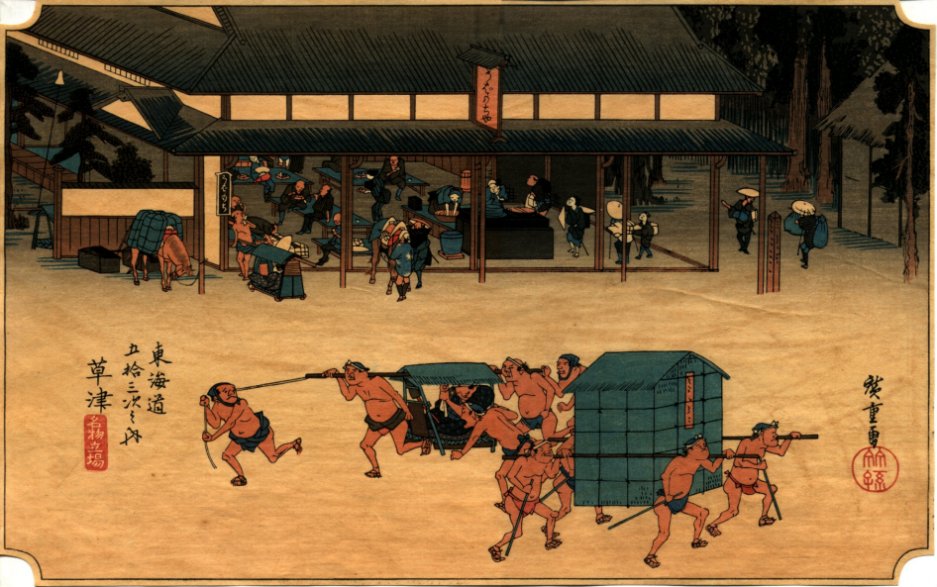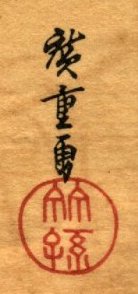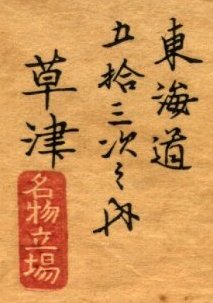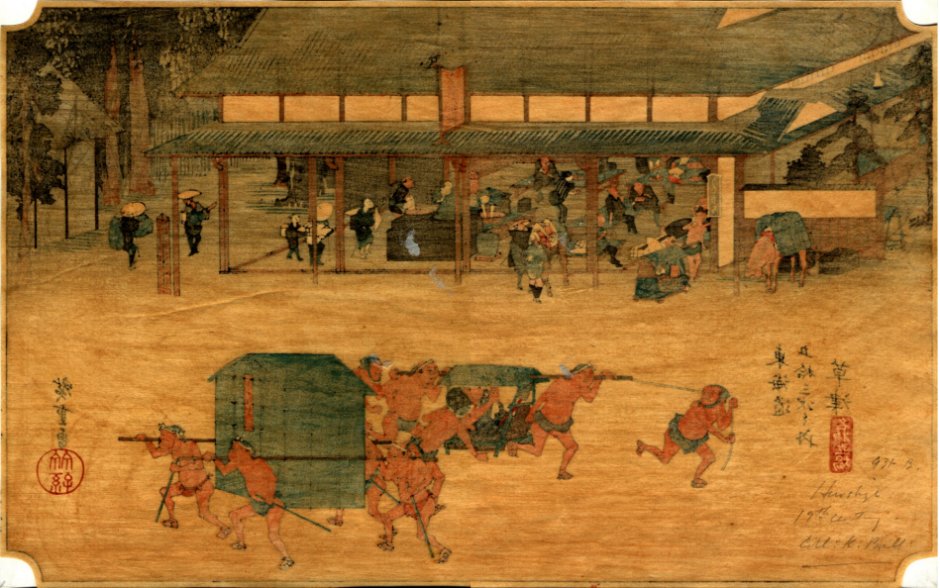







Station #52 " The Famous Tateba, Kusatsu" of the Famous Series of 53 Stations of the Tokaido
by Utagawa Hiroshige (A.D. 1797-1858)
日本十九世紀浮世繪大師安藤廣重(1797-1858)"東海道五十三次"系列之第52站"草津"
Size about 35.7cm x 22.7cm
52. The Famous Tateba, Kusatsu
The Nakasendô, another large highway which ran through the mountainous region between Edo and Kyôto joined the Tokaidô at this station to form a single highway for the remainder of the highway to Kyôto.
Utagawa Hiroshige (1797-1858)
Utagawa Hiroshige (1797-1858, sometimes called Ando Hiroshige) was the second of the two great masters of the Japanese landscape woodblock print, after Hokusai. He is particularly known for his scenes featuring snow and rain, which feauture in many of his best and most famous images, and which has led to his becoming know as "the artist of rain, snow and mist".
He was born (with the name Ando Tokutaro) in Edo (the name of Tokyo at that point in time), and originally was intended to follow the career of his father, a fire-watchman. After his parents' death in 1809, the orphan Hiroshige gravitated toward the art world, an inclination which had been encouraged by his father.
In 1811, he became a pupil of the woodblock artist Toyohiro, who had been a fellow-pupil with the great woodblock master Tokokuni under Toyoharu (all of the Utagawa school, the latter being the founder). In 1812 he was formally adopted into the Utagawa school, with the name Utagawa Hiroshige. He continued to hold his post as a fire-watchman, though, until 1823.
His early prints from the period 1818-1830 were initially book illustrations, and later mostly actor prints and bijin-ga, all in the classic Utagawa school style, created by such masters of the Utagawa school as Toyokuni.
In the early 1830's, he started to discover himself as an artist, starting on the landscapes which became his forte, and changing his signature to Ichiyusai (sometimes Ichiryusai). His first landscape series was in 1829 or 1830, entitled "Eight Famous Views of Omi", followed by a ten-print series "Famous Places of the Eastern Capital", which in addition to showing the influence of Hokusai, also marked the first revelations of Hiroshige's true genius.
In 1832 he made his first journey down the Tokaido highway, which resulting in his first great artistic success, the original "Fifty-Three Stations of the Tokaido", a series which catapulted him to contemporary fame and success. This series is is now also universally held among the greatest of all Japanese landscape prints, and one of the two best series he ever did.
The 53 Stations of the Tokaido
The 53 Stations of the Tokaido is Hiroshige's trademark series. The original Tokaido prints were completed in 1834, but Hiroshige returned to the subject again and again. There are actually 55 prints in the series. It includes not only the 53 way stations on the road from Tokyo to Kyoto, but also the starting point at the Nihon-bashi (Japan bridge) in central Tokyo, and the ending at Kyoto. Portions of the old Tokaido road are still preserved in Hakone, and much of the area is now a national park.
For a complete Ukiyo-e collection of the 53 Stations of the Tokaido, please click Here. Please note that the numbering of the stations may be different from the official one.
Click Here to See Other Woodblock Prints
Click Here to Go Back to Homepage